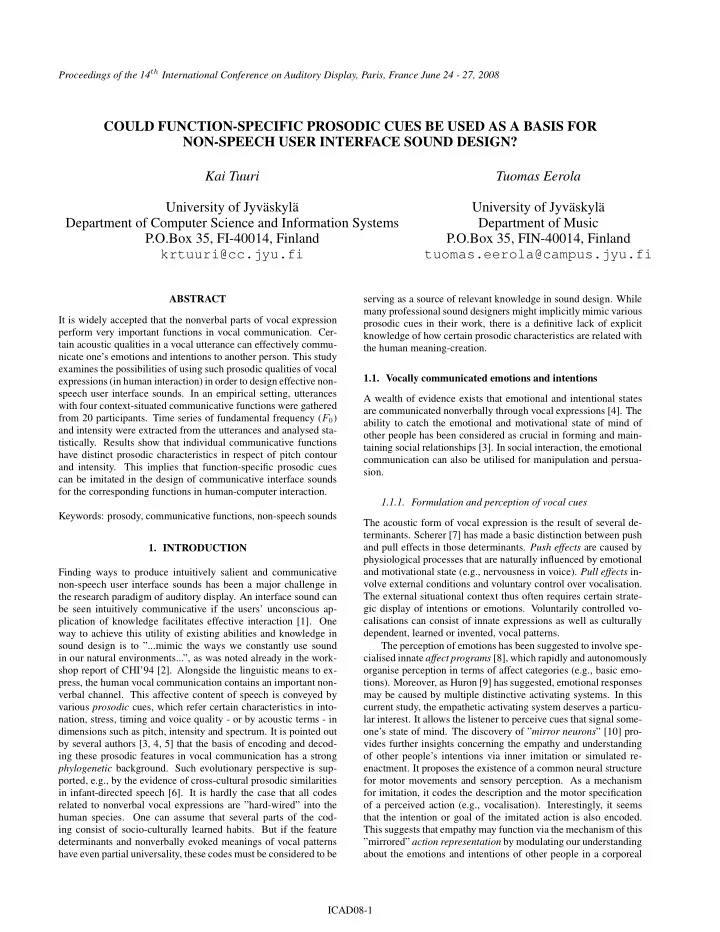

Proceedings of the 14 th International Conference on Auditory Display, Paris, France June 24 - 27, 2008 COULD FUNCTION-SPECIFIC PROSODIC CUES BE USED AS A BASIS FOR NON-SPEECH USER INTERFACE SOUND DESIGN? Kai Tuuri Tuomas Eerola University of Jyv¨ askyl¨ a University of Jyv¨ askyl¨ a Department of Computer Science and Information Systems Department of Music P.O.Box 35, FI-40014, Finland P.O.Box 35, FIN-40014, Finland krtuuri@cc.jyu.fi tuomas.eerola@campus.jyu.fi ABSTRACT serving as a source of relevant knowledge in sound design. While many professional sound designers might implicitly mimic various It is widely accepted that the nonverbal parts of vocal expression prosodic cues in their work, there is a definitive lack of explicit perform very important functions in vocal communication. Cer- knowledge of how certain prosodic characteristics are related with tain acoustic qualities in a vocal utterance can effectively commu- the human meaning-creation. nicate one’s emotions and intentions to another person. This study examines the possibilities of using such prosodic qualities of vocal 1.1. Vocally communicated emotions and intentions expressions (in human interaction) in order to design effective non- speech user interface sounds. In an empirical setting, utterances A wealth of evidence exists that emotional and intentional states with four context-situated communicative functions were gathered are communicated nonverbally through vocal expressions [4]. The from 20 participants. Time series of fundamental frequency ( F 0 ) ability to catch the emotional and motivational state of mind of and intensity were extracted from the utterances and analysed sta- other people has been considered as crucial in forming and main- tistically. Results show that individual communicative functions taining social relationships [3]. In social interaction, the emotional have distinct prosodic characteristics in respect of pitch contour communication can also be utilised for manipulation and persua- and intensity. This implies that function-specific prosodic cues sion. can be imitated in the design of communicative interface sounds for the corresponding functions in human-computer interaction. 1.1.1. Formulation and perception of vocal cues Keywords: prosody, communicative functions, non-speech sounds The acoustic form of vocal expression is the result of several de- terminants. Scherer [7] has made a basic distinction between push and pull effects in those determinants. Push effects are caused by 1. INTRODUCTION physiological processes that are naturally influenced by emotional Finding ways to produce intuitively salient and communicative and motivational state (e.g., nervousness in voice). Pull effects in- volve external conditions and voluntary control over vocalisation. non-speech user interface sounds has been a major challenge in the research paradigm of auditory display. An interface sound can The external situational context thus often requires certain strate- gic display of intentions or emotions. Voluntarily controlled vo- be seen intuitively communicative if the users’ unconscious ap- plication of knowledge facilitates effective interaction [1]. One calisations can consist of innate expressions as well as culturally dependent, learned or invented, vocal patterns. way to achieve this utility of existing abilities and knowledge in sound design is to ”...mimic the ways we constantly use sound The perception of emotions has been suggested to involve spe- in our natural environments...”, as was noted already in the work- cialised innate affect programs [8], which rapidly and autonomously shop report of CHI’94 [2]. Alongside the linguistic means to ex- organise perception in terms of affect categories (e.g., basic emo- press, the human vocal communication contains an important non- tions). Moreover, as Huron [9] has suggested, emotional responses verbal channel. This affective content of speech is conveyed by may be caused by multiple distinctive activating systems. In this various prosodic cues, which refer certain characteristics in into- current study, the empathetic activating system deserves a particu- nation, stress, timing and voice quality - or by acoustic terms - in lar interest. It allows the listener to perceive cues that signal some- dimensions such as pitch, intensity and spectrum. It is pointed out one’s state of mind. The discovery of ” mirror neurons ” [10] pro- by several authors [3, 4, 5] that the basis of encoding and decod- vides further insights concerning the empathy and understanding ing these prosodic features in vocal communication has a strong of other people’s intentions via inner imitation or simulated re- phylogenetic background. Such evolutionary perspective is sup- enactment. It proposes the existence of a common neural structure ported, e.g., by the evidence of cross-cultural prosodic similarities for motor movements and sensory perception. As a mechanism in infant-directed speech [6]. It is hardly the case that all codes for imitation, it codes the description and the motor specification related to nonverbal vocal expressions are ”hard-wired” into the of a perceived action (e.g., vocalisation). Interestingly, it seems human species. One can assume that several parts of the cod- that the intention or goal of the imitated action is also encoded. ing consist of socio-culturally learned habits. But if the feature This suggests that empathy may function via the mechanism of this determinants and nonverbally evoked meanings of vocal patterns ”mirrored” action representation by modulating our understanding have even partial universality, these codes must be considered to be about the emotions and intentions of other people in a corporeal ICAD08-1
Recommend
More recommend